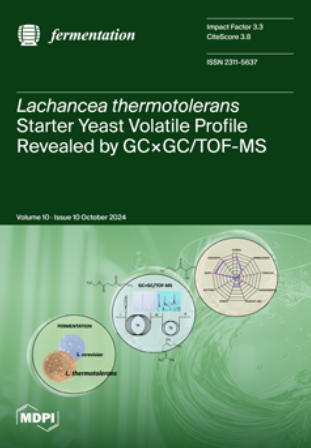黑曲霉TBG 28A固态发酵绿茶渣生产单宁酶:培养条件的优化
IF 3.3
3区 农林科学
Q2 BIOTECHNOLOGY & APPLIED MICROBIOLOGY
引用次数: 1
摘要
茶(Camellia sinensis)是一种常绿灌木,因其功能特性而闻名于世。目前全球绿茶产量约为每年530万吨。绿茶加工严重影响了农业工业废物的产生。减少废物积累的一种策略是通过固态发酵(SSF)对农用工业废物进行重新估价。本研究的目的是使用来自西高止山脉的地方菌株黑曲霉TBG 28A,在SSF下对绿茶加工残留物进行估价,以生产单宁酶。用接种了黑曲霉TBG 28A孢子的用过的绿茶叶在锥形烧瓶中进行SSF。采用Box–Benkhen实验设计进行生物工艺优化,实现了246.82(U/g)的高酶产量。本研究显示了单宁降解的复杂性和从黑曲霉TBG28A中获得的真菌单宁酶的不同表达模式。该酶被进一步纯化,获得16.35%的倍数纯化和150kDa的分子量。用一株新的黑曲霉TBG 28A菌株生产单宁酶是一种有趣的对绿茶废料进行再脱色的策略。本文章由计算机程序翻译,如有差异,请以英文原文为准。
Solid-State Fermentation of Green Tea Residues as Substrates for Tannase Production by Aspergillus niger TBG 28A: Optimization of the Culture Conditions
Tea (Camellia sinensis) is an evergreen shrub that is recognized worldwide for its functional properties. The current global production of green tea is approximately 5.3 million tons per year. Green tea processing has severely affected the generation of agro-industrial waste. One strategy for reducing waste accumulation is the revalorization of agro-industrial wastes via solid-state fermentation (SSF). The aim of this study was to valorize green tea processing residues to produce tannase under SSF using an endemic strain from Western Ghats, Aspergillus niger TBG 28A. SSF was performed in Erlenmeyer flasks with spent green tea leaves inoculated with spores of A. niger TBG 28A. Bioprocess optimization was carried out by employing the Box–Benkhen experimental design, achieving a high enzymatic yield of 246.82 (U/g). The present study shows the complexity of the degradation of tannins and the different patterns of expression of fungal tannase obtained from A. niger TBG 28 A. The enzyme was further purified to obtain a fold purification of 16.35% and a molecular mass of 150 kDa. Producing tannase with a novel strain of A. niger TBG 28A is an interesting strategy to revalorize green tea waste.
求助全文
通过发布文献求助,成功后即可免费获取论文全文。
去求助
来源期刊

Fermentation-Basel
BIOTECHNOLOGY & APPLIED MICROBIOLOGY-
CiteScore
3.80
自引率
18.90%
发文量
594
审稿时长
7 weeks
期刊介绍:
Fermentation-Basel is an international open access journal published by MDPI, focusing on fermentation-related research, including new and emerging products, processes and technologies, such as biopharmaceuticals and biotech drugs. The journal enjoys a good reputation in the academic community and provides a high-impact forum for researchers in the field of bioengineering and applied microbiology.
 求助内容:
求助内容: 应助结果提醒方式:
应助结果提醒方式:


